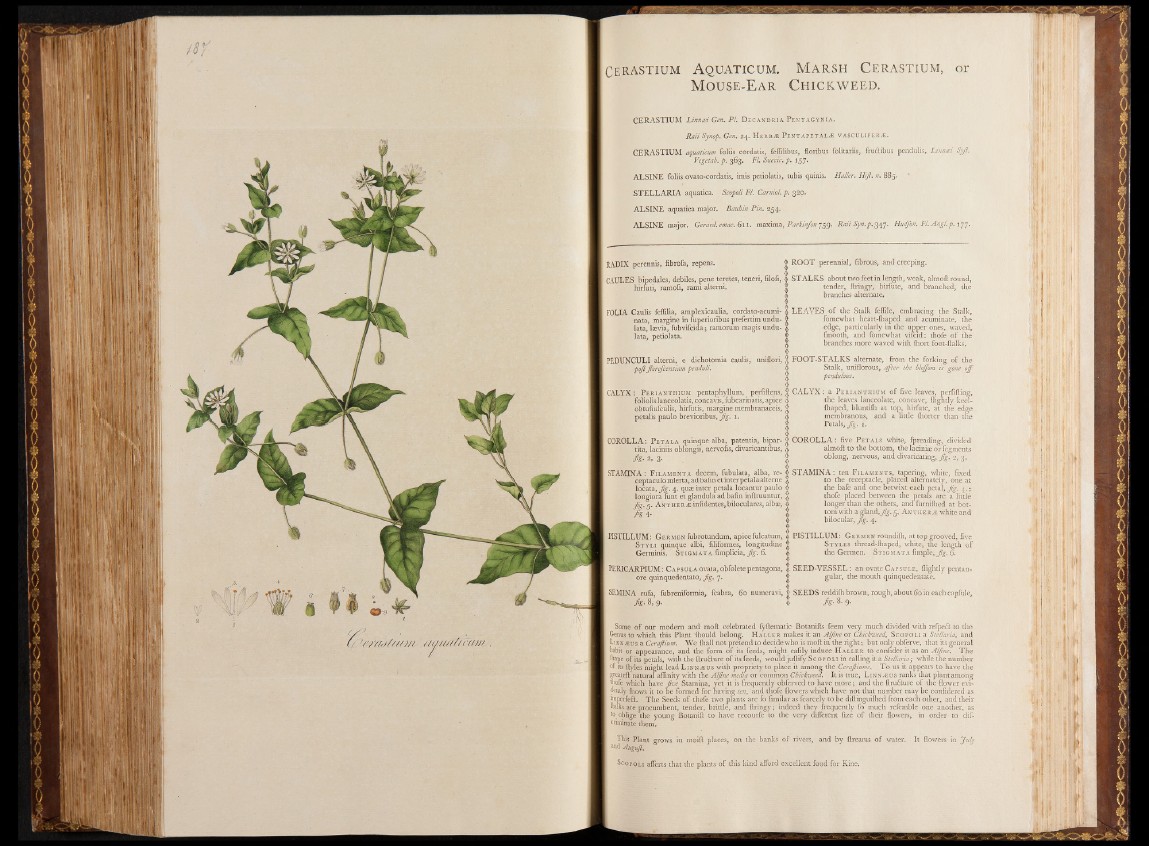
///)//
Cerastium Aquaticum. Marsh Cerastium,
Mouse-Ear Chickweed.
or
CERASTIUM Linnai Gen. PI. Decandria Pen tagynia.
RaiiSynop. Gen. 24. Herbie Pen tapetal# vascu-liferje.
CERASTIUM aquaticum foliis cordatis, feffilibus, floribus folitariis,. fru&ibus pendulis, Linnai Syfi.
Vegetab. p. 363. FI. Suecic. p. 157.
ALSINE foliis ovato-cordatis, imis petiolatis, tubis quinis. Haller. Hiß. n. 885. '
STELLARLA aquatica. Scopoli FI. Carniol. p. 320.
ALSINE aquatica major. Bauhin Pin. 254.
ALSINE major. Gerard, emac. 611. maxima, Parkinfon 759. Raii Syn.p. 347. Hudfon.Fl.Angl.p. 177.
RADIX perennis, fibrofa, repens. $
CAULES bipedales, debiles, pene teretes, tenen, filofi, 4$ hirluti, ramofi, rami altemi. $%i
FOLIA Cnaautali,s mfeaffrigliian,e ainm ipulpeexriicoaruilbiua,s pcroerfdearttiom-a ucnudmiii-- a| llaattaa,, lpaeevtiiao,l aftuab. vifciaa; ramorum magis undu- va
I
PEDUNCULI altemi, e dichotomia caulis, uniflori, A|
^ ‘P°ß florefcentiam penduli. I0
CALYX; Perianthium pentaphyllum, perfiftens, |
foliolis lanceolatis, concavis, fubcarinatis, apice $ - opbettualfiisu fpcauulilso, hbirrefvuitoisr,i bmusa,r gine membranaceis, $ fig. 1. 4<> 0 X
COROLLA: Pet ala quinque alba, patentia, bipar-
tita, laciniis oblongis, nervofis, divaricantibus, 4 3- . 1§. STAMINcAep: taFciullao minefenrttaa, a dd ebcaefrinn ,e tf iunbtuerla pteat,a laal balat,e mree- 02 llooncgatiao,r afi gfu. n4t. eqtu gaela inndteurl ap aedta blaa flionc iannftturur upnatuulro, $a
fig' 5' Anther^e infidentes, biloculares, albae, i>
.fig 4- l
PISTILLUM: G ermen fubrotundum, apice fulcatum, t4
SGteyrmliin iqsu. inque albi, filiformes, longitudine | Stigmata fimplicia, fig. 6. 40
PERICARPIUM: Capsula ovata, obfoletepentagona, 4
ore quinquedentato, fig. 7. ^ ' SEMINA rufa, fubreniformia, fcabra, 60 numeravi. , 0J>
fig- 8» 9-
ROOT perennial, fibrous, and creeping.
STALKSt eanbdoeur,t twftroi nfegeyt, inh liernfugtteh,, waneadk ,b aralmncohfet dro, utnhde, branches alternate,
LEAVESf oomfe wthhea tS thaelka rtf-eflhfialpe,e de manbdra caicnugm tihnaet eS, tatlhke, efmdgoeo,t hp,a ratnicdu lfaormlye iwnh tahte vuifpcpide:r othnoesfe, woaf vtehde, branches more waved with ffiort foot-ftalks.
FOOT-STSAtaLlkK, Su naiflltoerronuaste, , afftreorm th teh bel ofjfoormk iinsg goonfe thoeff
pendulous.
CALYX: thae Pleearvieasn ltanhcieuomla toe,f cfoivnec alveaev, e{sl, igphetrlyfi fktienegl-,
fmheampebdr,a nboluuns,t ifha nadt tao pl,i tthleir ffuhtoe,r teart tthhaen e dthgee Petals, fig. i .
COROLLA: five Petals white, fpreading, divided
almoft to the bottom, the laciniae or fegments
oblong, nervous, and divaricating, fig. 2, 3.
STAMINA: ten Filaments, tapering, white, fixed
to the receptacle, placed alternately, one at
the bafe and one betwixt each petal, fig. 4 .;
thofe placed between the petals are a little
longer than the others, and fumilhed at bot-.
tom with a gland, fig. 5,' A nther# white and
bilocular, fig. 4.
PISTILLUM: G ermen roundifh, at top grooved, five
tShtey Gleesrm tehnre. ad-fhaped, white, the length of Stigmata fimple, fig. o.
SEED-VESSEL: an ovate Capsule, flightly pentangular,
the mouth quinquedentate.
SEEDS reddifh brown, rough, about 60 in each capfule,
fig- 8.9,
GeSnoums eto o wf hoiuchr tmhiosd ePmla nat nfdh omulodf t bceelolenbgr.a ted fyftematic Botanifts feem very much divided with refpeft to the L Haller makes it an Alfine or Chickweed, Scopoli a Stellaria, and haibnint .oeru sa pap Cecarraafniicuem, . anWd eth {eh afollr nmo to pfr eittse nfdee tdos ,d emciidgeh wt heaof iilsy m inodftu icne the right; but only obferve, that its general lhape of its petals, with the ftru&ure of its feeds, would juftify Haller to connder it as an Alfine. The °f.its ftyles might lead L Scopoli in calling it a Stellaria; while the number inn-eus with propriety to place it among the Cerafiiums. To us it appears to have the
tghroefaet ewft hniacthu rhaal vaeff inity with the Alfine media or common Chickweed. It is true, L innaeus ranks that plant among dently fhows it to bfiev ef oSrmtaemdi nfoa,r hyaevt iintg i s frequently obferved to have more; and the ftruCture of the flower eviimperfe6t.
The Seeds of thefe two plantetsn ,a raen dfo thfiomfeil aflro aws efrcsa wrcheilcyh t oh abvee d nifotitn gthuaiftf ineud mfrboemr meaacyh hoet hceorn, fiadnedr etdh eaisr ftota loksb- laigree ptrhoec uymoubneng t,B toetnadneifrt, tbor ithtlaev, ea nredc ofutrrifneg yto; tihnde eevde ryth edyif fferreeqnut efnitzley ofof tmheuicrh f lroewfeemrsb, lei no noer daenro thteor , daifsmiminate
them.
anTd hMis Pglan t |gr ows in moift rpl aces, on ^th e banks of riversI, and by ftreams of water. ItJ f logwersi n July
Scopoli afferts that the plants of this kind afford excellent food for Kine.